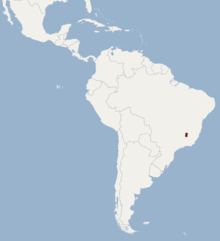Bokermann's nectar bat
Bokermann's nectar bat (Lonchophylla bokermanni) is a bat species from South America. It is endemic to Brazil. It feeds on nectar, and is listed as an endangered species.[1]
| Bokermann's nectar bat | |
|---|---|
| Scientific classification | |
| Kingdom: | Animalia |
| Phylum: | Chordata |
| Class: | Mammalia |
| Order: | Chiroptera |
| Family: | Phyllostomidae |
| Genus: | Lonchophylla |
| Species: | L. bokermanni |
| Binomial name | |
| Lonchophylla bokermanni Sazima et al., 1978 | |
 | |
Etymology
This species was discovered by Ivan Sazima and Marlies Sazima in 1974 in Serra do Cipó National Park. The species was described by Ivan Sazima, Luiz Vizotto, and Valdir Taddei in 1978.[2] It was named after Werner Carlos Augusto Bokermann—a prominent Brazilian herpetologist and former head of the bird department at the São Paulo Zoo.[3]
Taxonomy
While it was once thought to have a wider geographic range, a 2013 analysis concluded that the population of L. bokermanni in the Atlantic Forest was actually a new, separate species, Peracchi's nectar bat.[4] The implications of this taxonomic split were part of the reason that this species' listing was changed to endangered in 2016 by the IUCN, as it meant that it was not as widespread as previously thought.[1]
Description
It is a larger member of its genus. The forearm is 38.7–41.3 mm (1.52–1.63 in) long, and their total body length is 60–65 mm (2.4–2.6 in). Their total wingspan is 28 cm (11 in) long, and they weigh approximately 12 g (0.42 oz).[5][2] Their dental formula is 2.1.2.32.1.3.3. The nose-leaf is approximately 7 mm (0.28 in) long and 5 mm (0.20 in) wide. The ears are short and broad, and are rounded at the tips. Ears are approximately 14 mm (0.55 in) long and 9 mm (0.35 in) wide. The tragus is about 5.5 mm (0.22 in) long and pointed at the tip. The lower lip is furrowed and lined with 4-6 warts. The tongue is long and protrusible, with papillae at the tip. The calcar is short but distinct, at 7.5 mm (0.30 in) long. The plagiopatagium attaches at the ankle. All the flight membranes are hairless and dark in color. Their fur is dense and soft. Fur on the dorsal side is yellowish brown to grayish brown, and darker than fur on the ventral, which is ash gray to grayish brown. The ears and nose-leaf are light brown. It can be distinguished from other members of its genus by its short upper and lower tooth rows, trilobulate lower incisors, distinctly shaped second upper premolars, and narrow premolars and molars.[2]
Biology
This species is nectarivorous, and forages by trap-lining. They hover as they drink from flowers. They are known to feed from Encholirium glaziovii and Bauhinia flowers.[2][6] Each visit to a flower is brief, lasting only tenths of a second. The bat will circle a chosen flower before facing it to drink.[6] Stomach analysis shows that they also consume pollen and ants.[2] Between foraging bouts, they will take 5-30 minute breaks on short trees. They forage alone. Possibly, they undergo short migrations in response to food availability.[6] They have a karyotype of 28. The x-chromosome is medium-sized and metacentric, while the y-chromosome is small and acrocentric.[7]
Range and habitat
It is only found in the Cerrado of Brazil.[4] What was thought in 2010 to be an expansion of the species' previous range into the Atlantic Forest ended up as the discovery of a new, closely related species Peracchii's nectar bat.[8][4] Bokermann's nectar bat has only been confirmed in Jaboticatubas, Itambé do Mato Dentro, and Diamantina, all of which are in the Brazilian state of Minas Gerais.[1]
Conservation
In 1996, it was listed as vulnerable by the IUCN. In 2008, it was revised to data deficient, but it has since been uplisted to endangered. It is in danger of extinction because it is known to exist in fewer than five locations, its habitat is severely fragmented, and the habitat quality is projected to decline even further in the future.[1]
References
- Aguiar, L. 2016. Lonchophylla bokermanni. The IUCN Red List of Threatened Species 2016: e.T12263A22038287. https://dx.doi.org/10.2305/IUCN.UK.2016-3.RLTS.T12263A22038287.en. Downloaded on 06 September 2017.
- Sazima, I. V. A. N., Vizotto, L. D., & Taddei, V. A. (1978). Uma nova espécie de Lonchophylla da Serra do Cipó, Minas Gerais, Brasil (Mammalia, Chiroptera, Phyllostomidae). Revista Brasileira de Biologia, 38(1), 81-89.(in Portuguese)
- Beolens, B., Watkins, M., & Grayson, M. (2009). The eponym dictionary of mammals. JHU Press.
- Dias, D., Esberard, C. E. L., & Moratelli, R. (2013). A new species of Lonchophylla (Chiroptera, Phyllostomidae) from the Atlantic Forest of southeastern Brazil, with comments on L. bokermanni. Zootaxa, 3722(3), 347-360.
- Koopman, K. F. (1981). The distributional patterns of New World nectar-feeding bats. Annals of the Missouri Botanical Garden, 352-369.
- Sazima, I., Vogel, S., & Sazima, M. (1989). Bat pollination of Encholirium glaziovii, a terrestrial bromeliad. Plant Systematics and Evolution, 168(3), 167-179.
- Almeida, B., Novaes, R. L. M., Aguieiras, M., de França Souza, R., Esbérard, C. E. L., & Geise, L. (2016). Karyotype of three Lonchophylla species (Chiroptera, Phyllostomidae) from Southeastern Brazil. Comparative cytogenetics, 10(1), 109.
- Pimenta, V. T., Machel, C. T., Fonseca, B. S., & Ditchfield, A. D. (2010). First occurrence of Lonchophylla bokermanni Sazima, Vizotto & Taddei, 1978 (Phyllostomidae) in Espírito Santo State, Southeastern Brazil. Chiroptera Neotropical, 16(2), 740-742.
External links
- Sazima Network - Relevant Scientific Papers and Pictures.
